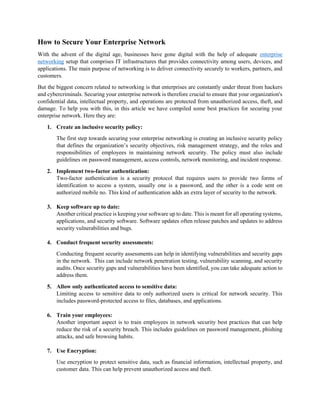How to Secure Your Enterprise Network.pdf
- 1. How to Secure Your Enterprise Network With the advent of the digital age, businesses have gone digital with the help of adequate enterprise networking setup that comprises IT infrastructures that provides connectivity among users, devices, and applications. The main purpose of networking is to deliver connectivity securely to workers, partners, and customers. But the biggest concern related to networking is that enterprises are constantly under threat from hackers and cybercriminals. Securing your enterprise network is therefore crucial to ensure that your organization's confidential data, intellectual property, and operations are protected from unauthorized access, theft, and damage. To help you with this, in this article we have compiled some best practices for securing your enterprise network. Here they are: 1. Create an inclusive security policy: The first step towards securing your enterprise networking is creating an inclusive security policy that defines the organization’s security objectives, risk management strategy, and the roles and responsibilities of employees in maintaining network security. The policy must also include guidelines on password management, access controls, network monitoring, and incident response. 2. Implement two-factor authentication: Two-factor authentication is a security protocol that requires users to provide two forms of identification to access a system, usually one is a password, and the other is a code sent on authorized mobile no. This kind of authentication adds an extra layer of security to the network. 3. Keep software up to date: Another critical practice is keeping your software up to date. This is meant for all operating systems, applications, and security software. Software updates often release patches and updates to address security vulnerabilities and bugs. 4. Conduct frequent security assessments: Conducting frequent security assessments can help in identifying vulnerabilities and security gaps in the network. This can include network penetration testing, vulnerability scanning, and security audits. Once security gaps and vulnerabilities have been identified, you can take adequate action to address them. 5. Allow only authenticated access to sensitive data: Limiting access to sensitive data to only authorized users is critical for network security. This includes password-protected access to files, databases, and applications. 6. Train your employees: Another important aspect is to train employees in network security best practices that can help reduce the risk of a security breach. This includes guidelines on password management, phishing attacks, and safe browsing habits. 7. Use Encryption: Use encryption to protect sensitive data, such as financial information, intellectual property, and customer data. This can help prevent unauthorized access and theft.
- 2. 8. Use of Firewalls and Intrusion Detection Systems: Firewalls and intrusion detection systems are crucial components of network security. Firewalls prevent unauthorized access to networks by blocking incoming traffic from untrusted sources. Intrusion detection systems detect and respond to potential security threats by monitoring network traffic for suspicious activity. 9. Monitor network activity: Monitoring network activity is essential for identifying potential security issues and taking swift action in response. This may involve keeping an eye on user activities, log files, and network traffic. This allows you to spot patterns and anomalies that can point to a security breach. 10. Prepare an incident response plan: You might still have a security breach despite your best efforts. A quick and efficient reaction can be facilitated by creating an incident response plan, which can assist in reducing the impact of a security breach. The strategy should outline steps for locating and containing the breach, notifying relevant parties, and resuming normal activities. I think by following these best practices, you can manage your network’s security effectively. You can also hire the best networking company in India for this purpose. They have a team of specialized professionals that can take care of your enterprise network and its security effortlessly. Source Link: https://whatitallbelike.com/technology/how-to-secure-your-enterprise-network/
